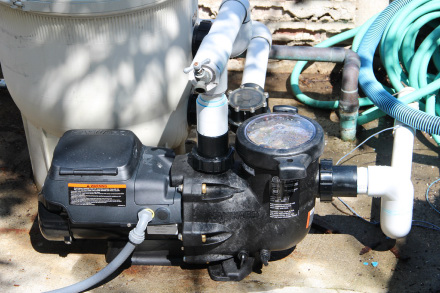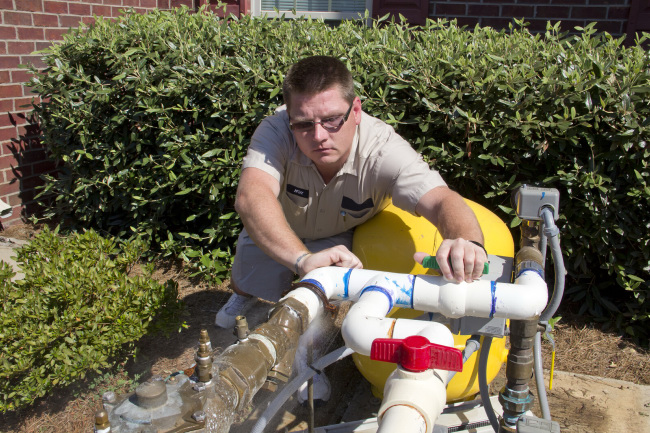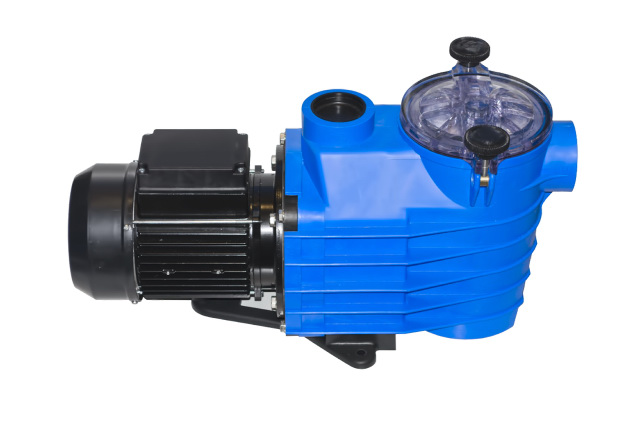When you got your swimming pool installed, you’d be the first to admit you didn’t know much of anything about pool pumps. Now, several years later, it’s a different story. You’re about to get a new pool pump and wondered about replacing it with something smaller and cheaper to run. Can you downsize?
Replacing a pool pump with a smaller model is OK in some situations. Pool pumps can be downsized if the current pump is too big for the pool and pool filter. You can either replace the pump or swap out the impeller and motor for a smaller size.
In today’s article, we’ll talk about how to know whether it’s time to downsize your pump, what the benefits of downsizing are, and how you can downsize your pump. You won’t want to miss it!

Article Contents
Can a Pump Be Too Big for Your Pool?
A pool pump can be too big for a swimming pool. Pumps need to be matched to the volume of the pool, the filter size, and the pipe size and lengths. The pump should be large enough to filter all of the pool’s water 1-2 times in 8 hours. But the pump shouldn’t be larger than the filter and pipe capacity.
When it comes to a pool pump, which promotes water circulation throughout your pool, your mindset might be “the bigger the better”. More circulation can’t ever be a bad thing, right?
Unfortunately, it can. Here are some of the risks you face when you run a pump that’s too big for your pool.
Pipe and Pump Damage
If the pipes are too small for the pump, which is likely if you oversized the pump either randomly or without meaning to, then here’s what will happen.
Your pump will want to pull large volumes of water; it is, after all, a large pump. Yet the pipes are only so big, and they physically cannot handle that volume of water.
This causes two potential problems:
1. Pump Cavitation
If the pump isn’t getting enough water to it, it will partially run dry, causing it to cavitate and pulse. And in bad cases, your pump may lose its prime regularly.
2. Pipe Damage
A large pump with small pipes causes an increase in pressure. The pipes can only withstand so much strain before they either leak or burst – usually this occurs at the joins.

Poor Filtering
Every pool filter has a minimum and maximum amount of flow. Based on that min and max flow, the pump size should be matched to suit.
If your pool pump exceeds the max filter flow, then it won’t be a much different story than what happened to your pool pipes. The filter pressure may be too high and could cause damage. The filter may not clean the water properly, either.
Related Reading: What to Do if Swimming Pool Filter Not Filtering Algae
The Benefits of Downsizing a Pool Pump
Although it’s always annoying to replace a pool part when it’s working perfectly fine, in the case of a too-large pool pump, the upgrade is warranted.
Here are some advantages of a more appropriately-sized pool pump.
Lower Electricity Costs
Although your bigger pump may seem to work well, have you ever thought about how it’s costing you a lot more money on your monthly electricity bills? You will once you’re charged.
Maybe the first month, you can write it off as a fluke, but when the bills are consistently higher, you’ll connect the dots and realize it’s due to your big pool pump.
Buying a pump that’s the right size for your pool will mean you’re optimizing the efficiency, and your electricity bills won’t be so costly anymore.
Better Filtering
The pool filter simply cannot do its job if the pump’s flow rate is greater than the maximum flow rate of the filter. The water will not be cleaned properly, dirtying up your pool.
You’ll feel like you’re constantly burning through chlorine to get rid of the murkiness or cloudiness, which is frustrating.
When your pool pump is rated between the filter’s minimum and maximum flow rates, the filter will work better so your pool will be cleaner. You can finally give that jug of chlorine a much-needed break!
Fewer Repairs
A pool pump that’s too large will put extra pressure on all the components in your pool’s system. Including the filter, pipes, pipe fittings, and valves. This extra pressure can shorten the life of these parts as well as the pump itself.
Signs You Need to Downsize Your Pool Pump
Let’s make this clear, you must match the appropriate size pump to your pool’s volume, filter size, pipe size, and the distance of your pump to your pool.
If you’re still debating whether you should get a smaller pool pump, the following pointers will help you decide.
1. The Pump is Cavitating
Is Your Pump Cavitating?
For those who are uninitiated, cavitation is when there isn’t enough water being supplied to the pump, for it to operate correctly. Basically, the pump is starved for water.
How Do You Know if Your Pump is Cavitating?
The pump is cavitating if it sounds like there are rocks in the pump. It’s like there are rocks rolling around inside the impeller, grinding. The mechanical damage from cavitation can be quite serious, and the pump can even fail if cavitation is ongoing.
Before you assume the cavitation is caused by having a pump that’s too big, make sure you have all of your pool valves open. This will allow the maximum possible water flow to the pump. If the sound goes away, you may have solved the issue.
And if you have a variable speed pump, it can be set to a speed that is too high. Just decrease the speed and see if the sound goes away.
2. The Pump Flow Rate is Too High for the Filter
The pump’s flow rate must match your filter. You can check this by looking at the specifications for your filter and your pump.
The flow rates are usually published in the instruction booklet or you can find them online. Just Google the model number of your filter to find this.
You’ll need to look at both the flow rate of the pump and the maximum flow rate of your filter. The pump’s flow rate should be less than the maximum flow rate of your pool filter.
When Is It OK to Use a Smaller Pool Pump?

Many people ask if it’s OK to use a 1hp pump instead of a 1.5hp pump. Or a 1.5hp pump instead of a 2hp pump.
Here’s when it is OK to downsize your pump to a smaller one:
1. The Pump Will Filter all of the Pool’s Water 1-2 Times in 8 Hours
It’s essential that the pool pump you’re considering is able to turn over the water 1-2 times in 8 hours. If the pump doesn’t allow for this, then it is too small. More on how to calculate this is below.
2. Flow Rate is Higher than the Filter’s Min. Flow
The pump is too small if the flow rate of the pump is below the filter’s minimum flow rate. Filters need a certain amount of water moving through them to work correctly. If they don’t have enough water, then the filter will not filter the water properly.
Related Reading: Do You Need a Pool Flow Meter? (and how to install)
Ways to Downsize a Pool Pump
As we touched on in the intro, you have two options for downsizing. Let’s explore them in more detail now.
1. Replace the Pump
Your first option is by far the easiest, even if it is a little damaging to your wallet. That is, you can just get rid of the large pool pump and buy one that’s a little smaller (or a lot smaller depending on how much you overdid it on the pump size).
For example, you may go from a 1hp to a 0.5hp, a 1.5hp to a 1hp, or a 2hp to a 1.5 pool pump.
The cost of a pool pump with installation starts at about $500 USD and goes up to around $1800, which we understand is not cheap. To offset the costs, you might consider selling your big pool pump, especially if it’s in relatively good condition.
After all, just because the pump wasn’t useful for you doesn’t mean it won’t be useful for someone else. If they have a bigger pool, then they can use your large pump without any risks of cavitation or damaging the filter or pipes.
A great option is a variable speed pump. With these pumps, you can program them to exactly the right speed to suit your system. That way, your pump will be the optimum size for your pool system.
2. Buy a Smaller Motor and Impeller
You can also sort of Frankenstein your way to a more functional pool pump by switching out certain components but keeping the pump itself. It depends on what model pump you have and what is available.
You’ll need to change both the impeller and the motor, keeping the pump body.
The motor is the heart and soul of the pool pump. Even if the pump has bigger housing, if the motor and impeller are smaller, then the pump won’t circulate water in such a large amount anymore. It will also use less electricity.
It will likely cost you a few hundred to several hundred dollars to swap out the pool pump motor and impeller. In many cases, it will be cheaper to replace the entire pump. Not to mention less effort.
What Size Pump Should You Get?
As you’ll recall, your pump should turn over the entire volume of your pool water 1-2 times in 8 hours. Here’s how you work out the size of the pump you need.
1. Calculate the Total Water the Pump Needs to Move
You need to know how many gallons of water your pool can hold. Divide this by the turnover rate of 8 hours for a turnover of one. Or 16 to get a turnover of two. That’s how much water you need your pump to move per hour.
2. Calculate the Required Gallons Per Minute
Then you need to take that number and divide it by 60 to gauge how many gallons of water your ideal pool pump can move per minute.
Let’s use an example to help you conclude what size pump you need.
If your swimming pool can hold 24,000 gallons (109,106 L) of water and the turnover rate is eight hours (which is standard), then dividing those numbers equals 3,000.
You’d next divide 3,000 by 60, which is 50.
In the case of our example, 50 means 50 gallons (227 L) per minute, which is the acceptable flow rate for your pool pump.
Related Reading: How to Choose the Ideal Swimming Pool Pump

